Yankun Xu
READS-V: Real-time Automated Detection of Epileptic Seizures from Surveillance Videos via Skeleton-based Spatiotemporal ViG
Nov 24, 2023



Abstract:An accurate and efficient epileptic seizure onset detection system can significantly benefit patients. Traditional diagnostic methods, primarily relying on electroencephalograms (EEGs), often result in cumbersome and non-portable solutions, making continuous patient monitoring challenging. The video-based seizure detection system is expected to free patients from the constraints of scalp or implanted EEG devices and enable remote monitoring in residential settings. Previous video-based methods neither enable all-day monitoring nor provide short detection latency due to insufficient resources and ineffective patient action recognition techniques. Additionally, skeleton-based action recognition approaches remain limitations in identifying subtle seizure-related actions. To address these challenges, we propose a novel skeleton-based spatiotemporal vision graph neural network (STViG) for efficient, accurate, and timely REal-time Automated Detection of epileptic Seizures from surveillance Videos (READS-V). Our experimental results indicate STViG outperforms previous state-of-the-art action recognition models on our collected patients' video data with higher accuracy (5.9% error) and lower FLOPs (0.4G). Furthermore, by integrating a decision-making rule that combines output probabilities and an accumulative function, our READS-V system achieves a 5.1 s EEG onset detection latency, a 13.1 s advance in clinical onset detection, and zero false detection rate.
Deep Learning for Short-Latency Epileptic Seizure Detection with Probabilistic Classification
Jan 04, 2023Abstract:In this manuscript, we propose a novel deep learning (DL)-based framework intended for obtaining short latency in real-time electroencephalogram-based epileptic seizure detection using multiscale 3D convolutional neural networks. We pioneer converting seizure detection task from traditional binary classification of samples from ictal and interictal periods to probabilistic classification of samples from interictal, ictal, and crossing periods. We introduce a crossing period from seizure-oriented EEG recording and propose a labelling rule using soft-label for samples from the crossing period to build a probabilistic classification task. A novel multiscale short-time Fourier transform feature extraction method and 3D convolution neural network architecture are proposed to accurately capture predictive probabilities of samples. Furthermore, we also propose rectified weighting strategy to enhance predictive probabilities, and accumulative decision-making rule to achieve short detection latency. We implement leave-one-seizure-out cross validation on two prevalent datasets -- CHB-MIT scalp EEG dataset and SWEC-ETHZ intracranial EEG dataset. Eventually, the proposed algorithm achieved 94 out of 99 seizures detected during the crossing period, averaged 14.84% rectified predictive ictal probability (RPIP) errors of crossing samples, 2.3 s detection latency, 0.32/h false detection rate on CHB-MIT dataset, meanwhile 84 out of 89 detected seizures, 16.17% RPIP errors, 4.7 s detection latency, and 0.75/h FDR are achieved on SWEC-ETHZ dataset. The obtained detection latencies are at least 50% faster than state-of-the-art results reported in previous studies.
Binary Single-dimensional Convolutional Neural Network for Seizure Prediction
Jun 08, 2022
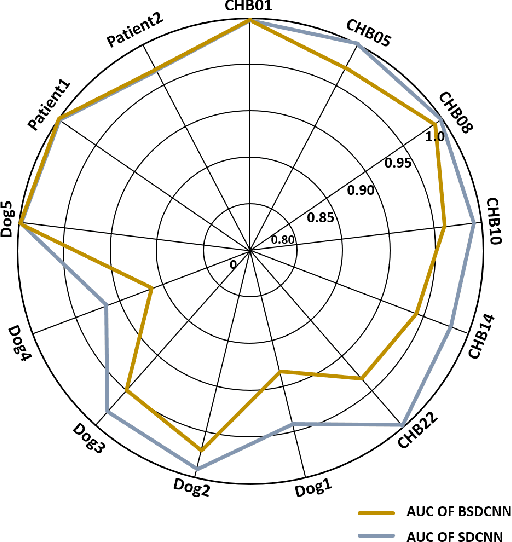

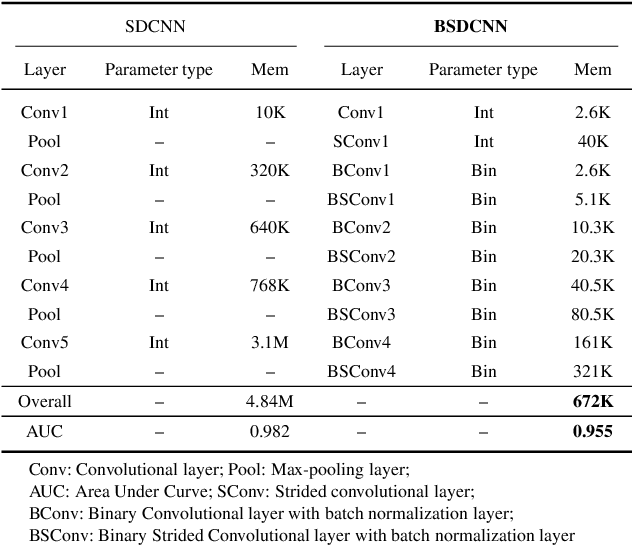
Abstract:Nowadays, several deep learning methods are proposed to tackle the challenge of epileptic seizure prediction. However, these methods still cannot be implemented as part of implantable or efficient wearable devices due to their large hardware and corresponding high-power consumption. They usually require complex feature extraction process, large memory for storing high precision parameters and complex arithmetic computation, which greatly increases required hardware resources. Moreover, available yield poor prediction performance, because they adopt network architecture directly from image recognition applications fails to accurately consider the characteristics of EEG signals. We propose in this paper a hardware-friendly network called Binary Single-dimensional Convolutional Neural Network (BSDCNN) intended for epileptic seizure prediction. BSDCNN utilizes 1D convolutional kernels to improve prediction performance. All parameters are binarized to reduce the required computation and storage, except the first layer. Overall area under curve, sensitivity, and false prediction rate reaches 0.915, 89.26%, 0.117/h and 0.970, 94.69%, 0.095/h on American Epilepsy Society Seizure Prediction Challenge (AES) dataset and the CHB-MIT one respectively. The proposed architecture outperforms recent works while offering 7.2 and 25.5 times reductions on the size of parameter and computation, respectively.
An End-to-End Deep Learning Approach for Epileptic Seizure Prediction
Aug 17, 2021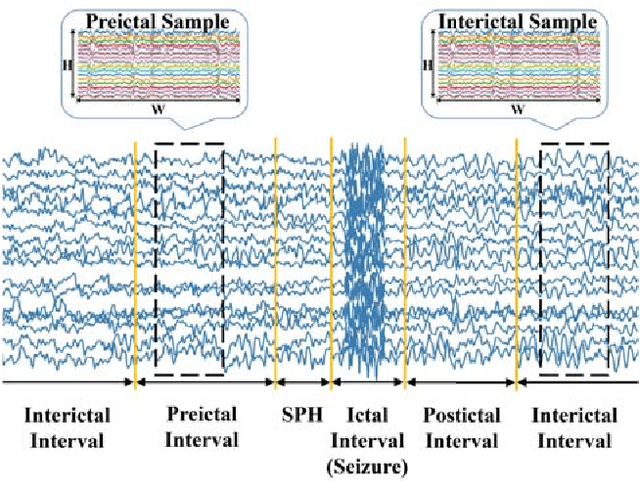

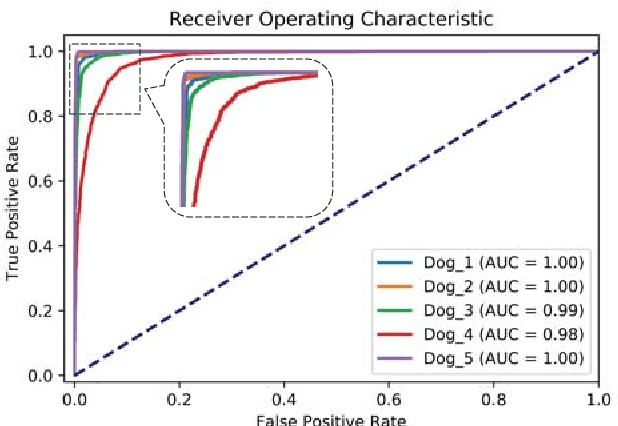
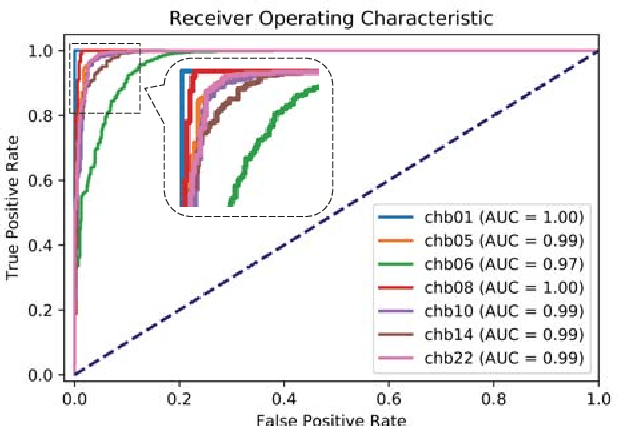
Abstract:An accurate seizure prediction system enables early warnings before seizure onset of epileptic patients. It is extremely important for drug-refractory patients. Conventional seizure prediction works usually rely on features extracted from Electroencephalography (EEG) recordings and classification algorithms such as regression or support vector machine (SVM) to locate the short time before seizure onset. However, such methods cannot achieve high-accuracy prediction due to information loss of the hand-crafted features and the limited classification ability of regression and SVM algorithms. We propose an end-to-end deep learning solution using a convolutional neural network (CNN) in this paper. One and two dimensional kernels are adopted in the early- and late-stage convolution and max-pooling layers, respectively. The proposed CNN model is evaluated on Kaggle intracranial and CHB-MIT scalp EEG datasets. Overall sensitivity, false prediction rate, and area under receiver operating characteristic curve reaches 93.5%, 0.063/h, 0.981 and 98.8%, 0.074/h, 0.988 on two datasets respectively. Comparison with state-of-the-art works indicates that the proposed model achieves exceeding prediction performance.
 Add to Chrome
Add to Chrome Add to Firefox
Add to Firefox Add to Edge
Add to Edge